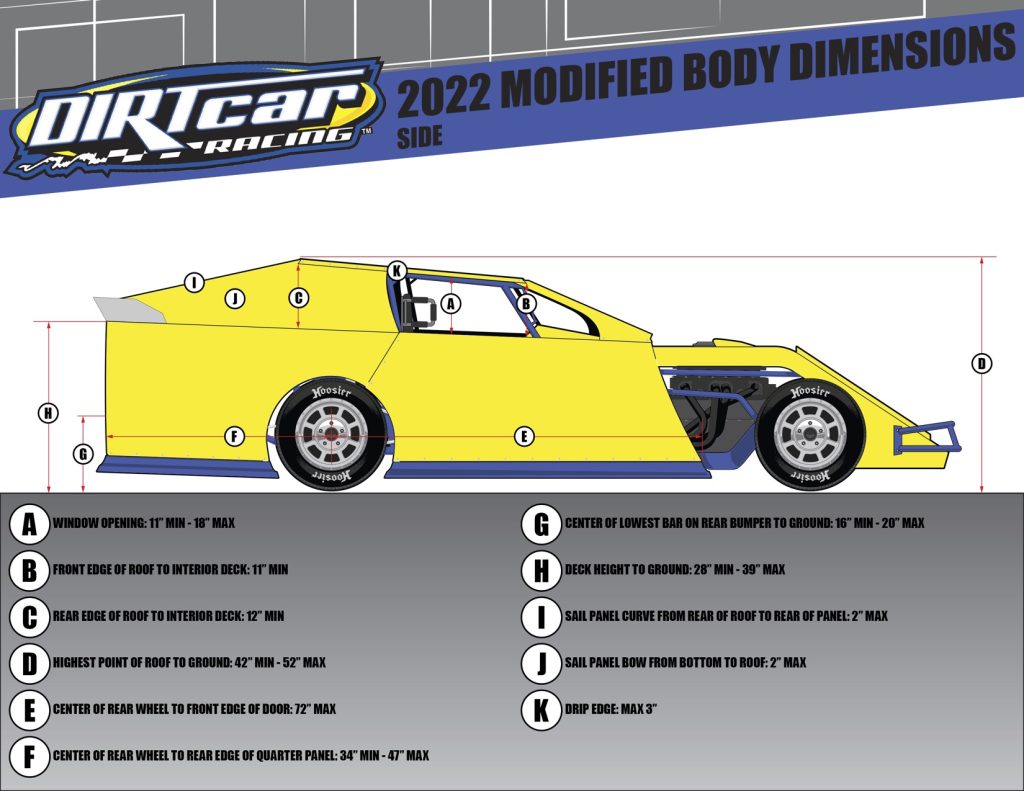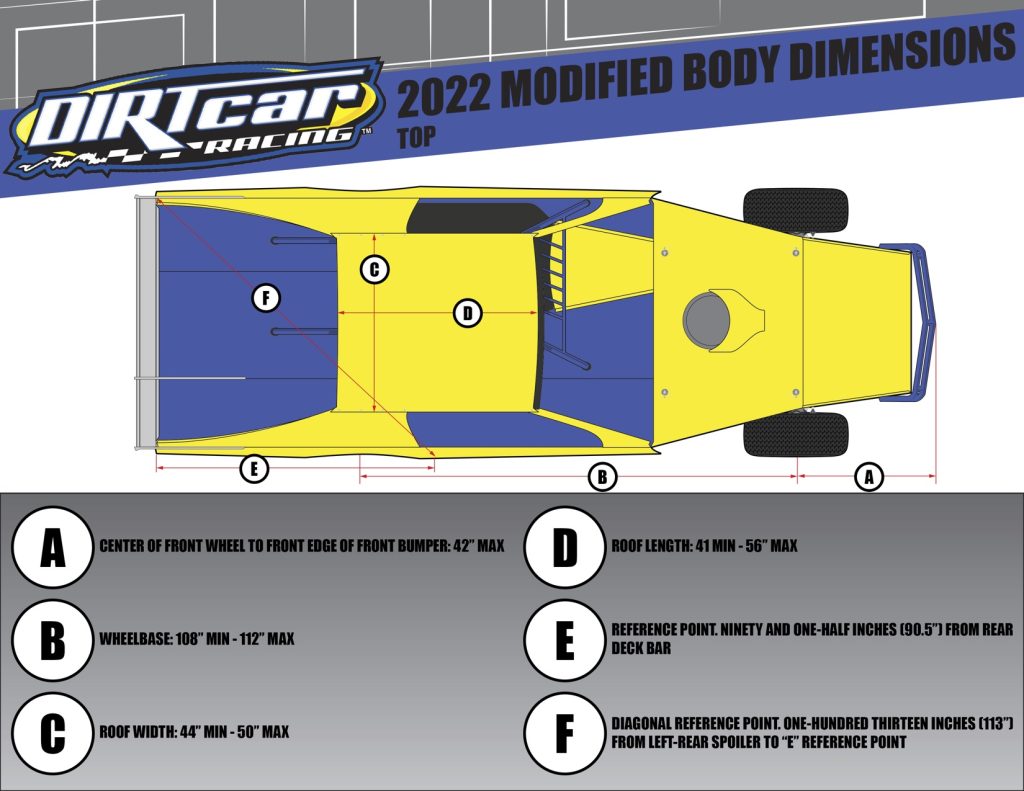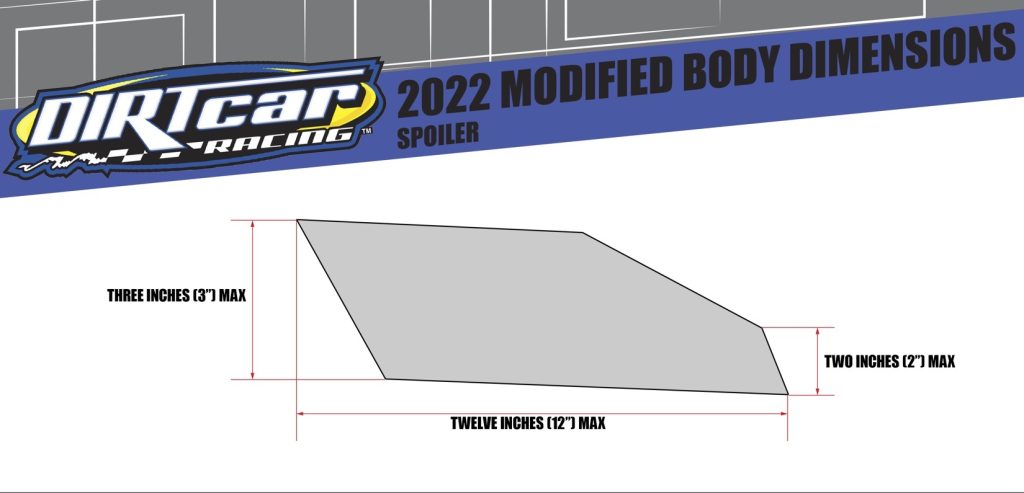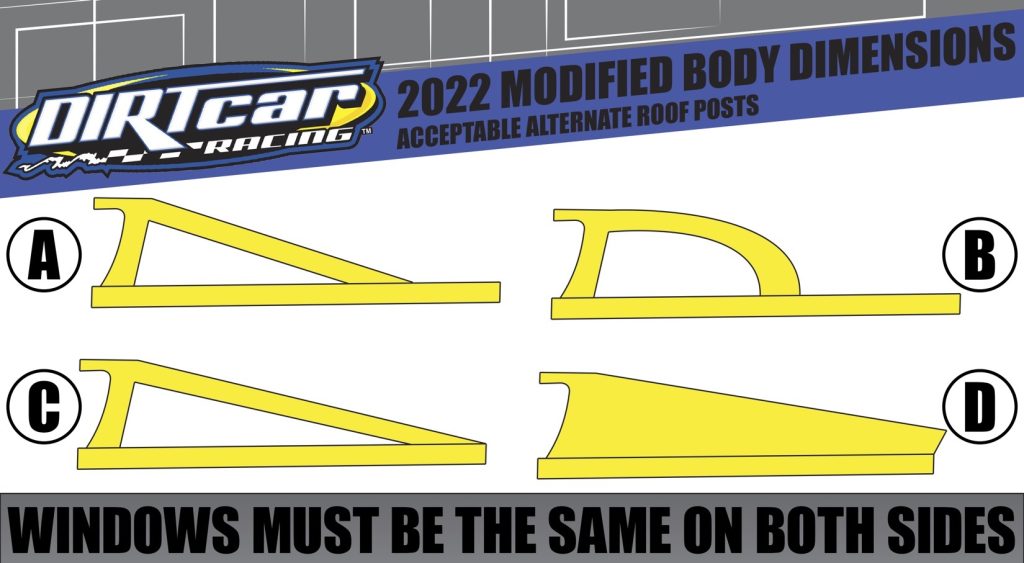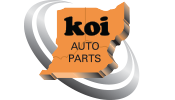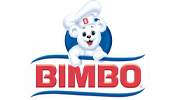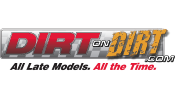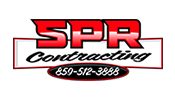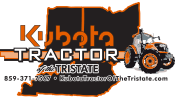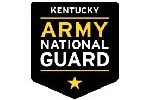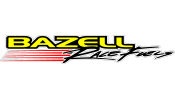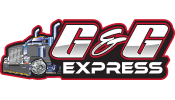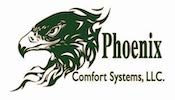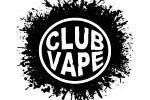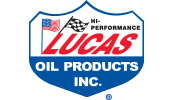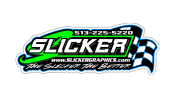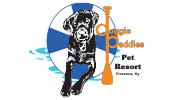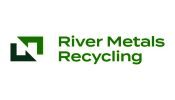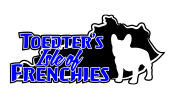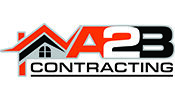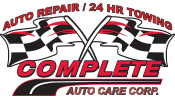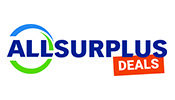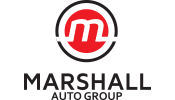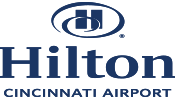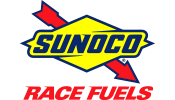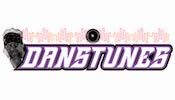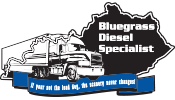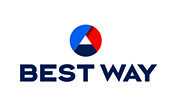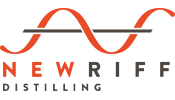G&G Express Sport Mod Rules
Revised: 11/20/2022; Changes Highlighted in Blue
Note: as we try to match rules with national series, including UMP body and car construction rules as much as possible. Because of that, these rules will not be finalized until those rules are updated for 2024.
Wheels and Tires
- Tires
- The following Hoosier tire compounds are the only tire compounds legal:
- 26.5/8.0-15 – M-30S, M-60
- 27.5/8.0-15 – M-30S, M-60
- Grooving of tires is permitted.
- Siping is permitted.
- Recapping of an approved tire is not permitted.
- Defacing or altering any of the manufacturer’s identification markings, letters, words, numbers, on any tire will not be permitted.
- Tire softeners and/or chemicals designed to alter the chemical characteristics of the tire and/or the tire surface will not be permitted.
- Any chemical treating of tires is illegal.
- Officials reserve the right to check and or confiscate any tire used in competition at any time. A driver is fully responsible for any tire used in competition regardless of the source of the tire and/or when the tire was put on the car.
- Officials can take tire samples using two methods.
- Officials can remove samples using destructive methods. In this case, no tires will be returned regardless of results. Drivers with treated tires will receive no compensation. Drivers with untreated tires will have the tire replaced.
- Officials can remove sample grooves from the tread of the tire. No compensation will be given to the driver for tires.
- Any tire used in competition may be protested for chemical treating by any driver competing in that same individual event(same feature, heat, qualifications, etc). Protest must be made to track officials prior to when the protested car returns to pit area. Protester must present $500 cash to official at time of protest.
- If tire is found to not have been treated, the protested driver will receive $150 for tire replacement even if destructive methods are not used.
- If tire is found to be treated, protester will receive $400 of their fee back with $100 being held for processing fees.
- All prize monies of drivers with tires taken for testing will be held until lab tests are received. If tire samples do not match the factory benchmark for that compound, the driver forfeits all monies won that night, not only those from the specific race where the driver was protested. (ie – A driver using a tire during qualifying that is found to be illegal will forfeit any monies won in heats, consis, or features that night.)
- Drivers with tires that do not match the factory benchmark will be disqualified for the event the samples were taken, be suspended 5 races, lose all championship points earned up to that point, be disqualified from any contingency programs for that season, and be subject to a $1,000 fine. These penalties are for a driver’s first offense. Further offenses will be handled on a case by base basis.
- Any driver refusing to submit tires for any testing or intentionally avoiding officials attempts to secure tires will be subject to the same penalties as those found using chemically altered tires.
- Any driver making a protest then backing out of protest may be subject to fines, suspensions, and/or other penalties.
- The following Hoosier tire compounds are the only tire compounds legal:
- Wheels
- Bead locks will be permitted on the right side only.
- Wheel discs shall be fastened to the wheel using a minimum of three (3)- 5/16 inch or (3) 1⁄4 inch diameter magnetic steel hex head bolts.
- The use of wheel discs with any other type of fastener will not be permitted.
- Only 8-inch racing wheels will be permitted. Wheels must not weigh over 30 pounds
- All wheels must be conventional one-piece magnetic steel and must be mounted with lug nuts. Aluminum, plastic and/or carbon fiber wheels will not be permitted.
- All wheels must be fastened to the hub with five lug nuts.
- Wheel spacers are permitted. Wheel spacers may only be manufactured from magnetic steel or aluminum. Exotic, heavy metals are not permitted. Wheel spacers must not exceed one (1) inch in thickness. Wheel spacers must not exceed a 6-1/2 inch outside diameter.
Engine
- There are two allowed engine configurations:
- The Chevrolet Performance Parts 602 crate engine (GM Part Number – 88958602) will be permitted for competition.
- All engines are to remain sealed from the factory. The original factory seals must remain unaltered, tampering, removal, modifications of any type and/or broken factory seals will not be permitted.
- Reseals are allowed, but must be done with current Crate USA, Dirtcar, IMCA, Mid-East or RUSH seals. Engine must be fully sealed with those or factory seals. Engines using other sealing systems, older versions of the above seals, or missing seals, will be considered open engines and must abide by all of the rules for that type engine.
- All 602 engines must have the newer flat top “Signa-Key” Type seals. Engines with the older dome type break away seals will be considered an open engine and must comply with all open engine rules below. It is the responsibility of the driver AND car owner to keep the seals in original condition, prevent them from rusting, and ensure that they are readable by the GM approved Engine seal program app. Unreadable seals are grounds for Disqualification.
- All crate engines must remain stock as they came sealed from the factory. Crate engines must not be altered, modified or changed from factory specs. No changes are allowed to the engine – intake manifold, heads, valve covers, front cover, oil pan, harmonic balancer or any other part / or parts on / or in engine.
- Officials may test any engine at any point to verify that the engine meets the GM factory specs. Testing can include compression checks, valve spring checks, rocker arm checks, and any other tests officials deem necessary. The officials may scan the seal bolts to verify they are the original bolts for that engine. Officials may also confiscate any engine at the completion of any event to perform a complete tear down of the engine.
- Any driver finishing a feature event may protest any other driver finishing in the top 5 in that same feature event. The driver must make protest to speedway officials immediately after feature event and must pay official $1,500 cash at that time. $500 will go to the speedway designated inspector. $1000 will go to the winner of the protest.
- A driver and/or car owner refusing to allow his engine to be tested or confiscated for official teardown or protest will be penalized the same as those found to be cheating within the sealing system.
- Any violation of the engine rules and/or factory specs inside the sealing system of the engine will result in the driver and owner being disqualified from that event. The driver and car owner will also be suspended from this division and any other that uses crate engines at Florence Speedway. This suspension is permanent.
- Any violation of the engine rules and/or factory specs outside the sealing bolts of the engine will result in the driver being disqualified from that event. Driver and/or owner may be suspended and fined at official’s discretion.
- Engine’s GM serial number must be clearly visible.
- Max 1 ¼” between intake and carburetor.
- Carburetor:
- Cars using the 602 crate engine above may use one of the following:
- One (1) four (4) barrel 650 cfm Holley carburetor, Part Number 4777 or 80777
- One (1) four (4) barrel 650 cfm Holley HP Carburetor Part Number 80541-1, (-2), (-3)
- One (1) two (2) barrel 500 cfm Holley carburetor Part 4412.
- No modifications with the exception of removal of choke plate.
- Straight, open, single hole spacer allowed.(NO Super sucker type spacers allowed.)
- No Super Bowl carburetors.
- Jets, power valve and accelerator pump may be changed.
- Carburetors will be checked by gauge to verify legality. This may include venturis, throttle bore, and the throttle bore and plate. Violation of any of these are grounds for disqualification and/or suspension.
- Cars using the 602 crate engine above may use one of the following:
- The minimum weight of car using the 602 engine above with driver at all times including after the race is 2,350 lbs. (Note: This weight requirement may be altered during the season as we work on balancing the engine configurations.)
- An open, steel block, steel head engine meeting the following specs:
- OEM steel block only. Block must be Chevrolet 350, Ford 302 or 351W, or Mopar 340 or 360. Maximum 390 cubic inch.
- 175 lbs. max compression(Hot). No Tolerance.
- Pistons must be dished or flat top. No domed or gas ported pistons.
- Hydraulic or flat tappet cams only. No roller cams. No 4-7 swaps.
- SFI Harmonic balancer required.
- Steel Heads Only.
- Must have stock diameter valve spring.
- No beehive or barrel springs or stud girdles.
- No porting or polishing.
- No canted valve/Cleveland style heads.
- No spacers between head and intake.
- Any 4 barrel open plenum intake.
- No porting or gasket matching.
- Max 1 ¼” between intake and carburetor.
- One 2 barrel Holley 4412 Carburetor.
- No modifications with the exception of removal of choke plate.
- Straight, open, single hole spacer allowed.(NO Super sucker type spacers allowed.)
- No Super Bowl carburetors.
- Jets, power valve and accelerator pump may be changed.
- Carburetors will be checked by gauge to verify legality. This may include venturis, throttle bore, and the throttle bore and plate. Violation of any of these are grounds for disqualification and/or suspension.
- The minimum weight of car using the open engine above with driver at all times including after the race is 2,500 lbs.
- OEM steel block only. Block must be Chevrolet 350, Ford 302 or 351W, or Mopar 340 or 360. Maximum 390 cubic inch.
- OEM style diaphragm fuel pumps only. Must be mounted in stock location.
- No trigger type ignition allowed. MSD or OEM HEI allowed.
- All cars must be able to be started without being pushed or pulled. Starter must bolt to engine at factory location. Only one starter per car.
- May use aftermarket headers. Exhaust system must be mounted in such a way as to direct spent gases away from cockpit of vehicle and away from areas of possible fuel spillage. Exhaust header outlets no higher than midline of the body sides. Officials may require turn downs on the collectors. Dual exhaust only no ”Y” pipes or 180 headers. No oxygen sensors allowed.
- The Chevrolet Performance Parts 602 crate engine (GM Part Number – 88958602) will be permitted for competition.
Transmission & Driveline
- Transmission
- The transmission must be bolted to the engine. All cars must have working forward and reverse gears and be able to shift to forward or reverse with the engine running. BERT-type transmissions will be permitted.
- Clutch-type transmissions must be equipped with explosion-proof steel bell housing. In lieu of an explosion-proof bell housing or if one is not available for your engine, a shield of at least 1/2” inch x 6”-inches covering the clutch area 360 degrees securely fastened in place and fabricated from magnetic steel will be permitted.
- Direct drives and/or any type devices will not be permitted.
- Driveshaft
- The drive shaft must be made from magnetic steel or approved carbon fiber. Aluminum or fiberglass driveshafts will not be permitted. The driveshaft must be painted white with the car number clearly labeled on the drive shaft.
- A 1/2”-inch x 2”-inch 18-gauge steel drive shaft hoop is mandatory. The drive shaft hoop must be at least six (6”) inches behind the universal-joint. Two hoops are strongly recommended. A single 1/8”-inch plate on the right side of the drive shaft tunnel is recommended.
- All competitors are encouraged to perform systematic checks on their drivetrain.
Fuel Cells and Fuel
- Fuel cells must be used in accordance with the manufacturers specifications. Alterations of any kind will not be permitted (example: alterations to top plate, alterations or removal of foam, etc.).
- Either meet FT3 or SFI 28.3 requirements and/or Include:
- Key components of an approved fuel cell are: a metal container, bladder, foam baffling for slosh and explosion suppression, flap valve and rollover vent valve, threaded or snap lock cap.
- Fuel valve plate, fuel pickup and fuel return fittings must be on the top of the fuel cell.
- The fuel cell must be completely enclosed in an 18-gauge magnetic steel container.
- Fuel cells that are not contained within a welded steel tubing “rack” must have two (2) equally spaced steel straps that measure two (2) inches wide by 1/8 inch in thickness that completely surround the fuel cell. The straps must be bolted to the frame. Longitudinal (front to rear) orientation is recommended for strap mounting.
- The maximum capacity for the fuel cell will be 32 gallons.
- All fuel cells must be completely visible.
- The fuel cell must not extend lower than protective tubing.
- Racing gasoline or alcohol will be permitted.
- Nitrous oxide, nitrous methane, propylene oxide or any type of additives will not be permitted.
Electrical Systems, Batteries and Electrical Accessories
- The battery must be securely mounted and shielded.
- The battery must not be mounted inside the driver’s cockpit.
Exhaust, Muffler and Sound Reduction Devices
- The exhaust system(s) must be mounted with the exhaust directed away from the vehicle and away from the ground. The exhaust system(s) must remain completely below the interior deck of the car. The entire exhaust system (including the exhaust pipe and/or header exits) must be inside all parts of the body. The only breach of any interior or exterior body panel that will be permitted is for routing the left side header or exhaust pipe on the left side of the car. When routing the left side header or exhaust pipe through the left side firewall a maximum of 1/2” inch clearance around the header or exhaust pipe will be permitted.
Ignition Boxes, Traction Control, Radios & Transmission Devices
- The following ignition boxes will not be permitted for use:
- MSD Red 6 Box – Part Number: 6530
- MSD Black 6 Box – Part Number: 65303
- MSD Gold 7 Box – Part Number: 7531
- Fast Ignition – Part Number: 307222
- Any engine using an HEI MUST use an unaltered MSD #8727CT Rev control.
- All MSD boxes, ignition boxes, and rev controls MUST be mounted out of the reach of the driver.
- ALL engines MUST be chipped or programmed to a maximum 6500 RPM.
- Any device that changes or has the ability to change the ignition advance is not permitted.
- All electronic and/or computerized wheel spin and/or ignition retardation and/or acceleration limiting and/or traction control devices of any type will not be permitted.
- A master ignition switch within easy reach of the driver is mandatory. The switch must be clearly labeled “ON” and “OFF”.
- Adjustable ping control devices, dial a chip controls, timing controls and/or automated throttle controls will not be permitted.
- All traction control devices utilizing wheel sensors and/or any means of measuring ground speed to control wheel spin will not be permitted.
- Adjustable restrictor plates will not be permitted.
- Remote control components of any-type will not be permitted.
- Radios and/or devices for transmitting voice and/or data will not be permitted.
- Data acquisition systems will not be permitted.
Chassis/Frame
- Only factory production full 1950 or newer parallel American passenger car frames will be permitted. The frame must be complete in front of firewall. Cutting of the frame in any way in front of firewall will not be permitted.
- The frame must remain unaltered and must meet the requirements of the attached drawing.
- The Right side frame rail may not be altered and/or raised and/or moved from the stock OEM location in any manner and must measure a maximum of six (6) inches from the ground to the bottom or lowest edge of the frame rail.
- The front cross member may be notched to allow clearance for the radiator only. The cross members must be plated to retain complete box configuration. 3 inches minimum for notching is required.
- Jeep, Bronco, 4-wheel drive, front wheel drive or sports car frames will not be permitted.
- The minimum wheelbase permitted will be 108” inches. The maximum wheelbase permitted will be 112” inches. No tolerance – measurements are as posted
- Fiberglass lift bars and/or rear torsion bars will not be permitted.
- Any frame may not be widened or narrowed and must be able to support the roll cage on both sides and must be full and complete on both sides.
- The minimum frame and body height from ground is four (4) inches.
- The front bumper must be mounted to the ends of the frame with the bottom loop parallel to the ground.
- A minimum of 1” diameter tubing and/or pipe is required to for towing of the vehicle.
- The rear bumpers must be constructed of tubing and/or flat stock. All rear bumpers and/or tubing utilized in the fabrication of the rear bumper assembly must have an end cap. The rear bumpers must protect the fuel cell.
- The bumper(s) (front and rear) when measured from their center(s) must have a minimum of 25” inches of ground clearance. There will be a two (2) inch tolerance, plus or minus regarding this dimension. The rear bumper and/or the nerf bars must not extend beyond the width of rear tires. All bumpers must have round edges. Sharp edges on any bumper and/or bumper surface will not be permitted.
- The brace bars forward of the roll cage must not extend higher than stock hood height.
- The rear push bars must not extend beyond six (6”) inches of the rear quarter panel(s).
- All side bars and bumpers must be capped on ends.
- The maximum overall width of the car, front and/or rear, shall not exceed 78” inches when measured from the outside of the tire tread on both sides of the vehicle. A maximum one (1”) inch spacer between the hub and wheel will be permitted. Steel and/or aluminum spacers will be permitted, provided the overall tread width of the vehicle does not exceed 78”-inches.
Roll Cage
- All cars must have a roll cage. The roll cage must be approved prior to competition and it must be welded to the frame. The driver’s head must not protrude above the top of the roll cage with the driver’s helmet on.
- The top of the roll cage must extend above the top of the driver’s helmet by a minimum of one (1) inch. The entire roll cage and all roll bar pieces must be fabricated from magnetic steel a minimum of .095” in thickness.
- The driver and right side door bars must be parallel to the ground and located perpendicular to the driver. There must be right side door bars. The side bars must be welded to the front and rear of the roll cage. No brazing or soldering is permitted. The door bars must have a minimum thickness of .095” and must have a minimum of 1-1/2” diameter. On the driver’s side there will be a minimum of three (3) door bars.
- Foot protection is mandatory. One piece of magnetic steel tubing, a minimum .095” in thickness, must be fastened and/or welded across the back of the engine with vertical tubing a minimum of .095” thick.
- The door side roll bars are mandatory and must extend into the door panels.
- The roll cage must consist of continuous hoops that are no less than 1-1/2” in diameter and must a minimum thickness of .095”.
- The roll cage must be mounted securely (welded) to the frame in a minimum of 6 (six) places.
- The roll cage must consist of a configuration of front and rear hoops connected by tubing on the sides and/or side hoops. Roll cage must be securely supported and braced. Gussets to brace any portion of the roll cage will be permitted.
Weight
- All added weight(s) must be painted white with the car number clearly labeled on each weight.
- All added weight(s) must be securely mounted to car with minimum of two (2) 1/2”-inch bolts that pass completely through each weight and the car. Weights that are mounted on the rear bumper or outside the body of the car will not be permitted. All added weight must be mounted below all windows and the interior sheet metal.
- All added weight(s) must be securely attached to the frame below the body decking.
- Frame is defined as the steel welded structure only.
- Any part that moves or is not a fixed component to the steel frame structure may not be used for any weight attachment.
- Weights attached to the rear bumper and/or outside the frame will not be permitted.
- Any car that loses any weight(s) during any event will be disqualified.
- Burn off and/or weight percentages and/or tolerance after the completion of any racing event will not be permitted.
- Minimum weight is determined by engine configuration. See engine section for weight requirement.
Body
(See drawing diagram for reference – There may be dimensions referenced in the drawing diagram that are not referenced in written rules and vice versa. All dimensions whether written and/or referenced in the drawing diagram dimensional are rule(s),)
- General Body
- All bodies must follow dimension(s) and the appearance as shown in diagram. The body shall be the fabricated modified body from approved vendors. The body must be symmetrical, including but not limited to doors, nose, sail panels, spoiler supports, etc…The body must be symmetrical, including but not limited to doors, nose, sail panels, spoiler supports, etc.
- The front windshield and rear window support must be stock appearing. The front window support(s) may have a clear Lexan support of no more than 16” inches including the roof post at the bottom and going straight to the roof. The support must be securely fastened in a positive manner.
- The sides of the engine compartment will remain open. Any side panels in the engine compartment area will not be permitted. A five (5”) inch drop on either side of the hood will be permitted and it must enclosed at the rear of the hood. The firewall on driver’s side must meet the front of the door. The firewall must be a minimum of 16”-inches in length from top-to-bottom.
- A maximum of one (1) stone deflector, mounted only on the right side of the car, for rear mounted oil pumps, oil filters, and for the main oil tank will be permitted. The deflector may be made of steel, aluminum, or heavy gauge wire. The cover may only be mounted near the unit and is designed to protect with a maximum size of eighteen (18”x18”) inches square and mounted only from the upper right frame rail to the lower right frame rail.
- All cars must have a car number on both sides and the roof that are at least 18” inches in height and 14” inches in width.
- The driver’s last name must be displayed under the car number in a legible font that is a minimum of eight (8 inch) high letters.
- A minimum of two (2 inches) of tire clearance from the body is required.
- The minimum ground clearance will be four (4”-inches).
- The maximum body width at the body’s widest part will be 72 inches. The minimum of width at the body’s narrowest part will be 53 inches. The top of the doors may have a maximum width of 67 inches. The bottom of the doors may have a maximum width of 68 inches. On the left side, the rear of the door may flare out six (6 inches) for tire clearance.
- The bottom of the flare must be curved and rounded not pointed in any fashion.
- The maximum rear width of the car must be 67 inches at the widest point.
- Nose
- A maximum of one (1 inch) flange on the outside edges (left and right side vertically) for the purpose of strengthening only will be permitted on the front nose only. Side fins and/or flanges of any kind along the length of the entire car (hood, front, and/or roof) will not be permitted.
- The nose piece must not exceed 45”-inches in width, centered between the frame rails and must not extend past the leading edge of the front bumper. The nose piece must have a minimum of 6 inches from the ground to the bottom edge of the nose piece.
- The MD3 D3 Modified Aero Valance is approved.
- Roof, Roof Posts, Roof Supports and Window Side Panels
- All roofs must be full size. Half-moon roofs will not be permitted. The rear edge of the roof may not be mounted more than 12” (twelve inches) past the rear axle. The roof must be symmetrical.
- Wings, roof spoilers or ground effects of any kind will not be permitted.
- A maximum of 5 fasteners on the rear of the roof will be permitted.
- All flat type roofs will be allowed a maximum 3”-inch difference in height between the front of the roof and the rear of the roof. This measurement may be taken from the interior and/or the ground. The rear of the roof must maintain the same height from side to-side.
- All curved type roofs will be allowed a maximum of 5”-inches in the front and 2”-inches in the rear. The break in the roof must be within 6”-inches from the center of the roof.
- Wedge roofs will not be permitted.
- Dished roofs will not be permitted. Roofs must be rounded side-to-side. Bead rolls will be permitted. The roof must be level from side to side with a 1”-inch wide x 1/8 inch thick stiffener in the center.
- The rear roof post must begin where it meets the back edge of the roof. The rear roof supports may not extend past the front side of the rear upright of the roll cage.
- The side vents on the front roof posts may extend rearward from the lowest point, a maximum of 16”-inches, then at a 90-degree angle to roof for one (1) configuration, side vents must meet the outside of the car.
- The roof side (sail) panel window size must be 10”-inches x 15”-inches and must match drawing number – 2- side view. The roof side (sail) panels must be the same design, length (top and bottom) on both sides of the car.
- Sail panels must be a straight line from top to bottom on the front edge. Outward bowing of the sail panel will not be permitted.
- When using the long roof side (sail) panels, They must be mounted in the same way as described above.
- If the long roof side (sail) panel is being used a 3”-inch radius will be permitted.
- Any sun shield must be on hinge for easy exiting, taping will not be permitted. The window opening must remain at a minimum of 12”-inches.
- All race cars in competition must meet the measurements illustrated in the attached drawing.
- The roof should be single thickness of material. The roll bar hoops must be exposed for inspection.
- If the roof is curved then a level will be placed on the top of the car and if the roof is 5”-inches or less in the front and 2”-inches or less in the rear and the break is in the middle then the roof will be permitted.
- The roofs must be stock appearing. The roof must maintain the same height on both sides. If an official determines the roof does not meet the requirements as stated above then a penalty as determined by the official may be determined prior to competition, additional weight and/or other penalties, unless the roof can be returned to within the parameter as stated above prior to competition in the event that the roof was inspected for.
- The minimum roof height is 42 inches with a maximum height of 52 inches.
- The maximum roof width will be 50 inches with a minimum of 44 inches. The roof must be level from side to side with a 1”-inch wide x 1/8 inch thick stiffener in the center.
- The maximum roof length will be 56 inches with a minimum roof length of 41 inches. A maximum of 5 fasteners on the rear of the roof will be permitted.
- The front roof post must be in a straight line from top to bottom. They must be the same on both sides.
- The maximum height on the rear roof post/sail panel vertical is 3 inches.
- Doors
- The top of the doors must remain in line with the rear engine plate. The bottom of the doors may extend a maximum of eight (8”-inches) past the motor plate toward the front of the vehicle. Any material that exceeds 8”-inches forward of the engine plate will not be permitted.
- Right panel from top of door to bottom of door may not be no more than 3 inches and must be mounted straight inside the bottom.
- Deck
- The minimum deck height is 28” inches with a maximum height of 39” inches.
- The deck height should measure within 1”-inch from side-to-side.
- The measurement from the center of the hub to the rear top of deck will be a minimum of 34” inches and a maximum of 48” inches.
- Interior decks must be flat from side to side.
- Option 1 – Interior decks must be flat from side to side. Interior decks may have up to a total of 6”-inches of “rake” from the most forward part of the deck to the most rearward part of the deck as described below. Interior deck from the rear of the seat forward may be flat or have up to 3”-inches of rake. The interior deck from the rear of the seat to the rear of the car cannot exceed 3”-inches of rake regardless of how much rake the front portion measures. The rake of the rear portion of the interior deck must be in a straight flat line from the rear of the seat to the rear of the car. If using this option you will not be allowed a spoiler.
- Option 2 – Interior decks may have up to a total of 3 inches of rake from front to back and must be flat side to side. If you are using this deck option then you will be allowed a 3 inch spoiler.
- The spoiler shall be a maximum of 3”-inches tall. Any spoiler angle will be permitted. Three (3) spoiler supports may be used; this includes side spoilers. The spoiler supports and side spoilers shall be 3” inches tall in the back and 2” inches tall in the front with a maximum total length of 12 inches at the bottom. The spoiler may be fabricated from lexan or aluminum.
- Interior and Driver Compartment
- All windows must have a minimum 11”-inch vertical opening. The entire interior must have a minimum of 11”-inches of clearance from the interior deck to the roof and all sections of the roll cage. The minimum window opening will be 12”inches. The interior deck sheet metal to the right side of the driver from the back of the seat forward should be fabricated on an angle from the driveshaft tunnel to the right side window to promote ease of exit for the driver through the right side and or front window opening.
- Hydraulic and/or pneumatic weight jacks, trackers, or similar adjustable components of any type will not be permitted.
- Mirrors of any type will not be permitted.
- The drivers compartment must be sealed from the engine and the race track. The rear bubble of the hood should be closed and sealed from the driver.
- Any car in competition must have right side door bars as part of the roll cage.
- Skew of Body (see diagram)
- The maximum width across the back of the car is 67”-inches
- The maximum length of the car is 90 1/2”-inches
- The maximum length of the car diagonally is 113”-inches inches with the minimum being 111”-inches.
Brakes
- All cars must be equipped with a working braking system on all four wheels and all four wheels must be able to stop/brake at all times.
- Front brakes must utilize a one piece O.E.M. or aftermarket O.E.M., magnetic steel hub and vented rotor assembly. Rear brakes must utilize magnetic steel vented rotors. Carbon fiber, aluminum, and solid disc rotors will not be permitted. Drilling, lightening and/or any alteration to the brake rotors or calipers will not be permitted. Brake rotors of excessive size or weight when compared to an O.E.M. brake rotor will not be permitted.
- Only stock O.E.M. and/or approved aftermarket calipers will be permitted.
- All calipers must mount solid. No brake floaters.
- Brake proportioning (bias) valves and a right front shut off valve are permitted.
Suspension
- Suspension/Steering designs and applications are constantly evolving. Although the intent of the suspension/steering rules are an attempt to accommodate the majority of suspension/steering and suspension/steering component designs and applications currently being used in competition, the rules cannot be absolute.
- Unless otherwise specified, suspension/steering components must be manufactured using magnetic steel only. This includes but is not limited to, shocks, hubs, all control arms (A-frames), axle tubes, tie rods, etc.
Steering
- An O.E.M. steering system applicable to the O.E.M. frame assembly must be used. The steering system must consist of 1 (one) reciprocating steering gear assembly, 1 (one) pitman arm, 1 (one) idler arm, 1 (one) center steering link (drag link), 2 (two) inner tie rod ends or spherical rod ends, 2 (two) adjusting sleeves, and 2 (two) outer tie rod ends or spherical rod ends. Additional components, braces, rods, etc. will not be permitted.
- O.E.M. or exact fit aftermarket replacement center steering (drag) link, pitman arm, and idler arm available at auto part replacement venues will be permitted. Aftermarket components must match O.E.M. for all specifications, dimensions and design. Only single point round tapered mounting holes and O.E.M. tapered ball studs will be permitted. **
- Fabricated center (drag) links, braces, etc. are not permitted.
- Steel spherical rod ends (heim joints) and fabricated magnetic steel tie rod adjusting sleeves will be permitted. 5/8″or larger spherical rod ends and fasteners must be used. The inner rod end must connect to the center steering link using a stud that is tapered to fit the center steering link on one end with a straight 5/8″stud on the opposite end, or the center steering link may be drilled to accept a 5/8″ bolt. The outer rod end may use a 5/8″ grade 8 bolt with a bump steer spacer to connect to the steering arm. The O.E.M. steering arm may be drilled to accept a 5/8″ bolt. Tie rod adjusting sleeves must be magnetic steel tubing.
- The steering shaft and interior mountings may be fabricated. The steering wheel must remain on the left side of the vehicle. The steering shaft must have at least 1 (one) universal type joint to allow shaft to “fold” under impact.
- All steering wheels must connect to the steering shaft with an approved quick release coupler. SFI certified steering wheel couplers are highly recommended.
Front Suspension
- All front suspension and steering components (except the upper control arm mounts) must utilize the original O.E.M. suspension and steering component mounting holes. All mounting holes must remain a single round hole as produced by the O.E.M. Adjustable mounts and/or “slugs” will not be permitted.
- Weight jacking bolts (wedge bolts) may be added to O.E.M. frame but, must be located within 1 (one) inch of the original centerline of the O.E.M. front spring location.
- Unless otherwise specified, the front suspension components must be O.E.M. serviceable parts and originate from the same O.E.M. frame manufacturer for that application.
- Unless otherwise approved, only O.E.M. and/or O.E.M. replacement type passenger car spindles will be permitted. Spindle O.E.M. manufacturer and model is optional. Fabricated spindles will not be permitted. Spindles must not be altered. O.E.M. spindles utilizing a removable steering arm must use the same O.E.M. steering arm originally supplied with the type and model of spindle being use or a fabricated steering arm that is an exact match (length, mounting holes, etc.). If a fabricated steering arm is used, competitors must be prepared to supply an O.E.M steering arm for an inspection comparison.
- One side lower control arm must maintain the OEM dimensions. The opposite side lower control arm must maintain the OEM dimensions +/- one (1) inch. The maximum outside to outside tread width measurement must not exceed 78”-inches.
- Alterations and/or relocation of the lower control arm mounts will not be permitted. Lower control arms may be O.E.M. lower control arms for the frame being used or approved fabricated lower control arms, which are mounted in the O.E.M. location and maintain the O.E.M. dimensions. Lower control arms must be the same length when comparing to O.E.M. right and left. The lower coil spring seat must be an integral welded component of the lower control arm. If using spherical rod ends (heim joints) as lower control arm mounts, the spherical rod ends (heim joints) must be welded to the lower control arm to prevent adjustment. Competitors must be prepared to supply an O.E.M lower control arm for an inspection comparison.
- Tubular-type upper A-frames will be permitted. The upper A-frame mounting locations may be relocated. Aluminum cross shafts will be permitted.
Axle Housing, Rear Differential
- The axle housing must be of the “closed tube” design utilizing “full floating” magnetic steel hubs and axle shafts. “Live axle”-type rear ends will not be permitted.
- Quick change rear ends will be permitted.
- The center section of the axle housing must be manufactured of either aluminum or magnesium.
- Axle tubes must be one (1) piece and manufactured of magnetic steel only. Axle tube internal inserts or external sleeves will not be permitted.
- The axle tube must not exceed (3) three inches O.D. (outside diameter) at any point from center section to hub.
- Rear differentials in all cars must be locked. Both rear wheels must always rotate in the same direction and never free wheel or turn at a different speed through the differential. Differentials may be locked by using a steel or aluminum spool, a steel or aluminum mini spool, or welding. Open, limited slip, traction sensitive, Detroit lockers or any other device that allows independent wheel rotation will not be permitted.
Rear Suspension
- Rear suspension configuration used on current and new chassis(s) must be the design commonly known as four (4) link. Older cars currently competing with other rear suspension designs will be allowed to compete until further notification.
- The frame/roll cage structure must have integral welded mounting brackets for the attachment of rear suspension components. Frame suspension mounts may be welded or bolted securely (without any movement) to the frame/roll cage structure.
- The only materials used to fabricate frame suspension mounts that will be permitted are magnetic steel or aluminum.
- Axle Housing Mounts
- Aluminum birdcages will not be permitted.
- Axle housing mounts may be a solid (welded) type or a floating type (birdcage) design.
- Only one (1) axle housing mount per side will be permitted.
- The final assembled axle housing mount must be a one (1) piece mount. When a floating type mount (birdcage) is fabricated using two (2) pieces, the two (2) pieces must create a common one (1) piece pivot (barrel). The two (2) pieces must be fastened or welded together to prevent independent movement of the two (2) pieces. The axle housing mount must attach directly to the axle tube with clearance only to permit rotation of the entire mount. Fore, aft or vertical movement of the mount or the axle housing within the mount will not be permitted.
- Only 2 (two) radius rods per side will be permitted to be connected from the axle housing mounts (birdcages) to the frame. Radius rods must be magnetic steel. Spring rods or any type of radius rods that change length dynamically are not permitted. (See Brakes 15.7.6D for floating caliper specifications)
- Radius rods must attach to the frame brackets and to the birdcages using metal spherical rod ends or mono ball type bearings. Non- metallic bearings and or bushings will not be permitted. All mounting holes for attaching radius rods must be round and properly fit the fastener being used to prevent movement.
- Independent rear suspensions will not be permitted.
- In regard to swing arm and/or Z-Link suspension, these suspension types are permitted. The shock on a swing arm or z-link rear suspension may mount to the bird cage or bottom radius rod. Top and bottom solid links must be mounted on hiems and run in the opposite direction of bird cage.
Shocks and Springs
- One (and only one) coil or leaf spring per wheel must be used. Coil springs must be manufactured from magnetic steel. Rear leaf springs (if used) may be either magnetic steel or an approved composite material. All coil springs must be a minimum of 5 (five) inches in diameter. Coil springs must be wound with all coils being the same O.D., I.D. from the top to the bottom of the spring. The coil spring wire diameter must be the same from the top to the bottom of the spring. Coil spacing must be equal. Round coil spring wire must be used. Coil springs with linear spring rates are the only coil springs permitted. Air springs are not permitted.
- Front coil springs:
- The top of the front coil spring must be closed end and ground flat.
- The upper front coil spring mount must be flat and support the top of the spring 360 degrees.
- The lower end of the front coil spring must be an open end with a maximum gap of 1/4 inch between the “tail” of the spring and the next coil.
- The lower front coil spring mount may have a single step to prevent spring rotation and accommodate the open end of the spring. The step of the lower front coil spring mount must not exceed one (1) inch in height. The lower coil spring mount must be a welded integral component of the lower control arm. When installed the lower end of the front coil spring must be supported 360 degrees.
- Rear Coil Springs:
- The top and bottom of the rear coil spring must be closed end and ground flat.
- The upper and lower rear coil spring mounts must support the spring for 360 degrees.
- Rear steel coil-over eliminators and/or steel/aluminum coil-over kits will be permitted. The coil-over eliminators and/or coil-over kits must conform to the shock and spring rules.
- Only one coil spring per wheel will be permitted.
- All rear springs must have a tethered and/or cable system in place to securely fasten them in position in the car.
- One and only one coil spring will be permitted on the lift bar and or brake spring. Lift bar and or brake springs must be a minimum of 5”-inches in diameter.
Shocks
- Only steel, smooth body, non-adjustable shocks will be permitted. No Schrader valve, bulb, screw off top, bump stop, or remote reservoir allowed. Removable heim joint is allowed.
- Coils over shocks of any type on the front of the car will not be permitted.
- Only one shock per wheel will be permitted. Lay down shocks less than 12” (twelve inches) away from brake rotor will not be permitted.
- Shock Claim:
- Any driver finishing on the lead lap of a feature, may claim any one(1) shock from the feature winner’s car. Claims are $150 and are for shock only(as it comes from the manufactured).
- A driver wanting to make a claim must make the claim to a speedway official with cash in hand, in the infield immediately after the feature event.
- Only the driver can make a claim.
- If the claim is accepted, the driver may return their car to their pit to remove the shock. However, the shock must only be removed in the presence of a speedway official.
- A driver refusing to allow a claim is disqualified for that event.
Electronics, Gauges and Dash Modules
- Two-way communication devices in and/or attached to the race vehicle or on the driver’s person will not be permitted.
- Cellular, satellite, and wi-fi, devices in and/or attached to the race vehicle or on the driver’s person will not be permitted (Including cell phones and/or smart watches).
- Antennas will not be permitted in and/or attached to the race vehicle or carried by the driver.
- All forms of vehicle position systems will not be permitted. (GPS)
- Only approved lap timing and or lap time recording devices (transponders) will be permitted.
SAFETY EQUIPMENT
Safety equipment specifications listed below are listed as a guide and are only a minimum standard. These minimum standards may not be sufficient enough to protect a driver from injury or death from some incidents. It is the responsibility of the driver, car owner, and crew to ensure that the safety equipment on the car is properly installed, working as intended, and is sufficient to protect the driver from any incidents that occur. This may include using safety equipment that goes above and beyond the minimum specifications and recommended equipment listed below.
- Batteries:
- NO batteries to be located in the drivers’ compartment/cockpit.
- The battery must be securely mounted with positive fasteners and brackets.
- The battery terminals must be insulated or enclosed with a non-conductive material that will prevent contact with any part of the race car should the battery become dislodged from the battery mount.
- One (1) mandatory battery disconnect switch must be installed. The switch must be clearly labeled with off/on direction. The switch must be directly in-line with the NEGATIVE battery cable and be capable of completely disconnecting the NEGATIVE terminal of the battery from the race car. Negative or “ground” wiring connections must not be made anywhere from the battery negative terminal to the input side of the disconnect switch.
- Seats:
- Full containment type seats constructed of aluminum to the general design specifications of SFI 39.2 standards are highly recommended. Design should include comprehensive head surround, shoulder and torso support system, energy impact foam, and removable head foam.
- Up fitting a current seat with bolt on kits will be permitted with a seat manufacturer produced kit and a base seat acceptable to the seat manufacturer. Components should include comprehensive head surround, shoulder and torso support system, energy impact foam. Must be installed in accordance to seat manufacturer’s instructions.
- Seats must be used as supplied and instructed by the seat manufacturer with the exception of trimming the length of the left side head surround for the purpose of egress only. If the left side head surround is trimmed to a distance that is less than the most forward surface of the drivers helmet (usually the area crossing the chin) then a left side head net meeting the SFI 37.1 must be installed with a quick release latch.
- Seats must be mounted to a seat frame that is welded to the race car frame/roll cage structure. Attaching points, angles, and materials for the seat frame and mounting of the seat to the seat frame must be in accordance to the seat manufacturer’s instructions.
- Restraints:
- The use of a 5, 6 or 7 point driver restraint system certified to SFI Spec 16.1 or 16.5 is REQUIRED no exceptions. All driver restraint systems shall not be in excess of 3 years of age past the date of manufacture. The use of a 7 point driver restraint system is strongly recommended. All mounting points of the racing harness MUST be mounted properly in accordance with the manufacturer’s instructions, and securely mounted to the chassis with the use of grade 5 or better hardware.
- Window Nets:
- Window Nets certified to SFI Spec 27.1 are highly recommended and must be mounted in accordance with the manufacture’s instructions and technical director’s satisfaction.
- Driver Worn Equipment:
- A helmet certified to Snell SA2015/FIA–8859–2015, Snell SA2020/FIA–8860–2018, SFI 31.1/2015 or SFI 31.1/2020 is required to be always worn during competition or on the racing surface.
- A driver suit certified to SFI Spec 3.2A/5 is REQUIRED.
- Gloves certified to SFI Spec 3.3/5 are REQUIRED.
- Socks and Shoes certified to SFI Spec 3.3 are REQUIRED.
- Head and Neck Restraint Devices/Systems are Highly Recommended
- At all times during an Event (practice, qualifying, and competition), drivers must connect their helmet to a head and neck restraint device/system certified to SFI Spec 38.1. The device/system must display a valid SFI Spec 38.1 label. The head and neck restraint device/system, when connected, must conform to the manufacturer’s mounting instructions, and must be configured, maintained and used in accordance with the manufacturer’s instructions
- Drive Line:
- A driveline “sling” is REQUIRED.
- Cockpit Tubs:
- Eighteen (18)-gauge steel or one and one-eighth inch (1 1/8″) aluminum “cockpit tub” to protect front, sides and rear of driver is HIGHLY RECOMMENDED.
- Fire Suppression:
- An in-car Fire Suppression system is Highly Recommended.
- All race cars should be be equipped with a thermally deployed automatic fire suppression system. The fire suppression system will consist of a DOT approved cylinder manufactured from aluminum or steel with a capacity of ten (10) lbs. of fire extinguishing agent, steel or steel reinforced lines, and two (2) thermally activated discharge nozzles.
- All systems must meet or exceed SFI 17.1 specifications.
- Systems must be fully charged with ten (10) lbs. of DuPont FE-36, 3M NOVEC 1230, or Fire Aide and display a legible and valid SFI and manufacturer label depicting fire extinguishing agent, capacity, and certification date. Cylinders that or beyond useful certification date must be inspected, serviced and re-labeled by the manufacturer.
- Cylinders must be mounted forward of the fuel cell. Cylinders must be securely mounted to the frame/roll cage assembly. The certification label must be unobstructed and easily accessible for inspection when the mounting is complete.
- The cylinder must be connected to the nozzles with steel or steel reinforced lines.
- Two (2) thermally activated nozzles must be used. One (1) nozzle must be located directly above the fuel cell in the fuel cell area and the second nozzle must be located in the driver cockpit area.
- An optional manual override cable may be added to the system.
- Drivers under the age of 18 are REQUIRED to have a HEAD SOCK, window net, gloves, and either a neck collar or a head and neck restraint system in addition to all other required safety equipment in place.
